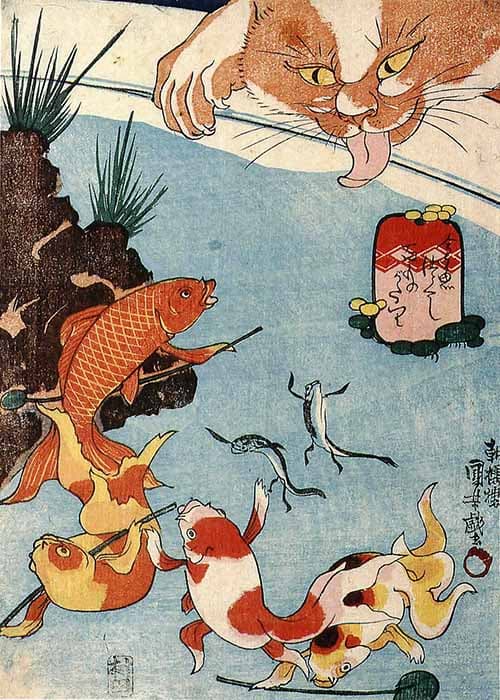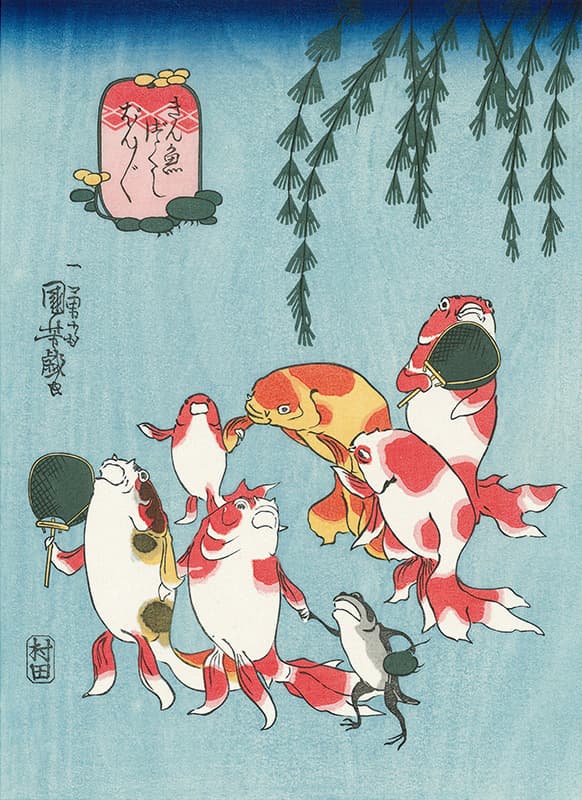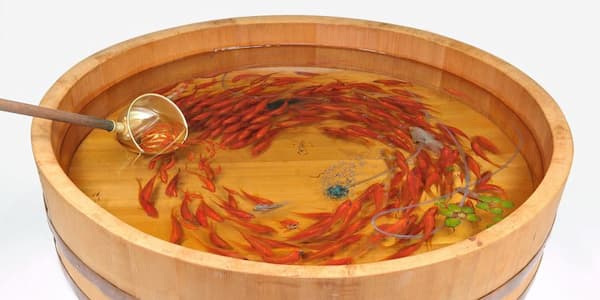Two visually stunning icons habitually greet visitors to Japan. One, of course, is the iconic Mount Fuji towering over the Kanto plains. The other icon is rather more subtle and it was first brought to Japan in 1502 by Chinese traders. Believe it or not, it is the humble goldfish initially sold to samurai and nobility. Representing wealth, fortune, and good luck the goldfish quickly became a highly prized pet.

Utagawa Cat and Goldfish
In Japan, the ideal color was a vermillion with a gold glint, as this combination represents wealth and simultaneously dispels illness and misfortune. For rather a long time the goldfish was a pet reserved for aristocracy but at the beginning of the 19th century the goldfish became a revered part of everyday people. And predictably, it became a symbol of beauty in Japanese art. But as we all know, the image of the goldfish made its way into Western Classical music as well.
Claude Debussy: Images, Book 2 “Poissons d’or” (Peter Frankl, piano)

Utagawa Kuniyoshi’s “Goldfish”
The goldfish arrived in Japan during the Muromachi period, a time when Japan was in friendly contact with the Ming dynasty in China. China had sought help in suppressing Japanese pirates in coastal areas, and trade between the countries flourished. As such, the goldfish eventually found its way into the genre of art known as ukiyo-e. It literally translates to “floating world pictures,” reflecting the Buddhist concept of life as a transitory illusion. This artistic movement appealed to a broad spectrum of the Japanese public as the process of woodblock printing was capable of producing large quantities of prints that could be circulated at low cost. Artists developed a distinct pictorial character for their art that frequently depicted idyllic narratives of nature, beauty, poetry, spirituality, love, and sex. Goldfish were bred to have long and elegant fins to reflect this floating aesthetic. One of the most famous ukiyo-e artists was Kuniyoshi Utagawa (1989-1861), who had a particular love for goldfish. Goldfish are portrayed as people in various situations and predicaments, including fending off the house cat.
Mieczyslaw Weinberg: 21 Easy Pieces, Op. 34 “The Goldfish” (Allison Brewster Franzetti, piano)

John Thomas’ “The Boy with Goldfish”
The first Japanese visitors arrived in the Kingdom of Hawaii at the beginning of the 19th century. In time, labourers and immigrants from Japan established small settlements, and some of their artistic visions inspired Kona art. “The Boy with Goldfish” is a series of Hawaiian legend paintings by John Thomas (1927-2001). Thomas specialized in producing a series of paintings centred on one specific subject. With the “Goldfish” series, Thomas “united storied Narcissus, Apollo, the drugged Tristan, and the demi-god Maui to create a trans-Hawaiian legend in which nature plays as significant a part as does the central figure of a boy in search of his anima.” Jerré Tanner, a long-time resident of Hawaii, had always been attracted to myth and folklore, and the “Boy with Goldfish” series inspired him to compose a heroic fantasy for soloists, chorus and orchestra in 1974.
In “Goldfish”, Tanner calls upon his experiences with nature to create musical equivalents “for thunder and lightning, for the stillness of a pool, for the ocean from which the sun dawns and for the final glory of the rainbow.”
Jerré Tanner: Boy with Goldfish, “Goldfish” (Leon Siu, vocals/guitar; Malia Elliott, vocals; Nigel Brooks Chorale; London Symphony Orchestra; Timothy Farrell, organ; Lee Holdridge, cond.)

Realistic painting from Ryūsuke Fukahori’s “Goldfish Salvation” exhibition
The goldfish remains a favourite among Japanese people today. Different varieties are cultivated around the country, and various festivals celebrate this colourful “Carassius auratus.” In fact, big patches of goldfish are annually transferred between Tokyo and Hokkaido, as it is difficult for the fish to survive in the intense winter up north. The goldfish also remains a central element in popular culture and a sought-after object in Japanese art. Ryūsuke Fukahori has become internationally known for his resin-based studies of Japanese goldfish. He calls himself a “goldfish artist,” and his hyper-realistic creations emerge by alternately pouring resin into a vessel and painting goldfish with acrylic paint, giving a three-dimensional optical effect. It can take several months for a single work of art to be completed, and according to the artist, “the domestication and breeding of goldfish becomes a metaphor for the stifling conditions of modern life.” Fukahori’s goldfish are permanently frozen in time and space, but on occasion, even goldfish get their requiem.
For more of the best in classical music, sign up for our E-Newsletter
Stephen Perillo: Requiem for a Goldfish (Russian Festival Orchestra; Yuval Waldman, cond.)

